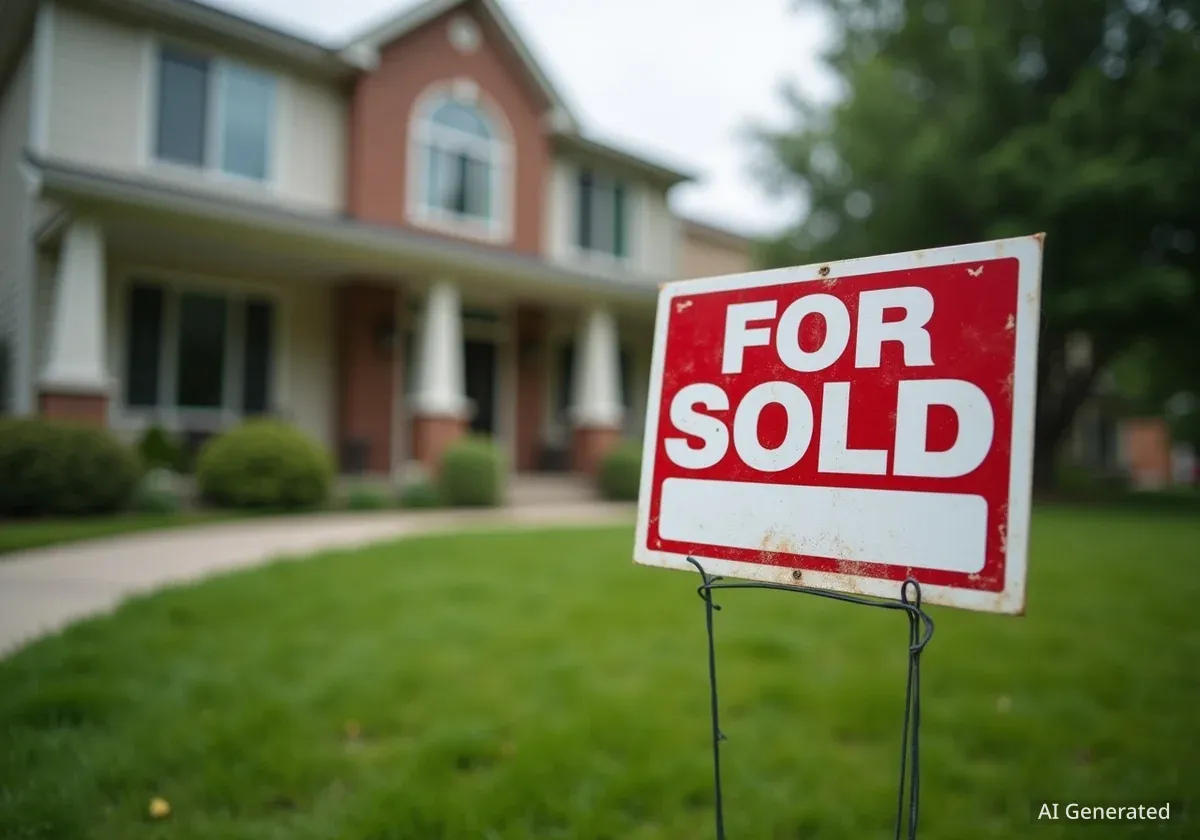Mortgage rates have decreased in every U.S. state between the first and second quarters of 2025, according to a new report. While national averages remain above 6%, significant regional variations offer potential relief for homebuyers, with the largest rate cuts concentrated in the South and Midwest.
A comprehensive analysis by WalletHub reveals that 40 states experienced double-digit percentage drops in mortgage rates. Alabama saw the most substantial decrease at 16.65%, while Idaho currently holds the lowest average interest rate in the nation at 4.35%.
Key Takeaways
- Mortgage rates declined in all 50 states from Q1 to Q2 2025.
- The national average for a 30-year fixed mortgage was 6.3% for the week ending September 25.
- Southern and Midwestern states saw the most significant rate reductions, with Alabama leading at a 16.65% decrease.
- State-level interest rates vary widely, from Idaho's low of 4.35% to New Jersey's high of 6.85%.
- Despite rate drops, high home prices and overall rates above pandemic-era lows continue to challenge the housing market.
National Housing Market Overview
Prospective homebuyers continue to face a challenging market characterized by high borrowing costs. According to Freddie Mac, the average interest rate for a 30-year fixed-rate mortgage stood at 6.3% for the week ending September 25. This figure represents a slight increase from 6.26% the previous week and is higher than the 6.08% rate recorded during the same period in 2024.
These elevated rates, combined with record-high home prices, have created significant affordability hurdles. The national median home list price in August was $429,990, contributing to what analysts describe as a difficult period for the housing sector. The market is currently on a trajectory for one of its slowest years for sales in the last three decades.
Pandemic-Era Rate Comparison
The current rate environment is a stark contrast to the conditions during the COVID-19 pandemic. Many current homeowners and prospective buyers became accustomed to mortgage rates that frequently fell between 2% and 4%. This historical low has made the current rates above 6% a major factor in buyer hesitation and has limited housing market activity.
State-Level Rate Reductions Offer Hope
Despite the challenging national picture, a recent proprietary data report from WalletHub indicates a positive trend at the state level. The report confirms that average mortgage rates decreased in every state between the first and second quarters of 2025. This universal decline suggests a potential shift in lending strategies across the country.
The magnitude of these decreases varies significantly by region. In 40 states, the rate drop was in the double digits, indicating a substantial change. The most aggressive rate cuts were observed in the South and Midwest, while coastal and Northeastern states saw more modest reductions.
"The rankings suggest lenders in lower-cost housing markets are cutting rates more aggressively to encourage activity," WalletHub analyst Chip Lupo explained to Realtor.com®. "For buyers, that means lower monthly payments in areas where homes are already cheaper than in coastal markets, making these regions especially attractive right now."
This strategic rate cutting could help stimulate sales in more affordable regions, potentially redirecting buyer interest away from perennially high-demand coastal markets.
A Wide Spectrum of Rates
The WalletHub data highlights a broad range in mortgage rates across the nation. As of the second quarter of 2025, the lowest average rate was 4.35% in Idaho, while the highest was 6.85% in New Jersey. This difference of 2.5 percentage points can translate to hundreds of dollars in monthly payments for the same loan amount.
Top States for Mortgage Rate Decreases
The new data provides a clear picture of which states are offering the most significant relief to borrowers. While the report did not list all 50 states, it detailed the performance of several key areas, particularly those with the largest rate reductions.
Alabama Leads the Nation
Alabama secured the top position with an impressive 16.65% decrease in its average mortgage rate. This substantial drop brought the state's average rate down from 5.78% in the first quarter to 4.82% in the second quarter. This new rate is near the lows seen during the pandemic era, making homeownership more accessible.
Combined with Alabama's below-median home prices, the state has become a more attractive destination for buyers. However, the report also notes a potential risk, as Alabama ranks 21st among states adding the most mortgage debt, suggesting new homeowners are taking on significant financial obligations.
Mississippi and Iowa Follow Suit
Mississippi ranked second for the largest rate decrease. Despite this positive development, the state's average rate remains the 25th most expensive in the country. On a positive note, Mississippi is making progress on existing debt, ranking 24th among states where mortgage delinquency is decreasing the most. New borrowing in the state remains limited, with Mississippi ranking only 39th for adding new mortgage debt.
Iowa saw the third-biggest rate decrease nationwide. However, its overall average rate is still relatively high at 5.5%, placing it as the 21st highest in the U.S. This may explain why the state ranks 42nd in decreasing mortgage delinquency. Similar to Mississippi, Iowans are not taking on significant new debt, also ranking 42nd in that category.
State-by-State Financial Health
The report's findings connect mortgage rate changes to broader financial behaviors:
- Alabama: Largest rate cut but 21st in adding new mortgage debt.
- Mississippi: Second-largest cut, but 39th in adding new debt, showing borrowing restraint.
- Iowa: Third-largest cut, but 42nd in adding new debt, indicating low risk-taking.
- Vermont: Experienced the smallest rate decrease in the country at just 6.73%.
Implications for the American Homebuyer
The data underscores a crucial message for anyone looking to buy a home: location matters more than ever. While national headlines focus on high rates, regional markets are telling a different story. The significant rate cuts in states like Alabama, Mississippi, and Iowa create pockets of opportunity where affordability is improving.
For potential buyers, this means that shopping for a mortgage should involve looking beyond national lenders and exploring local credit unions and banks that may be offering more competitive rates to stimulate their regional markets. The trend of lenders in less expensive areas cutting rates more aggressively could signal a longer-term shift, making the Midwest and South increasingly popular for homebuyers seeking affordability.
Ultimately, while the housing market remains challenging on a national scale, the widespread decrease in mortgage rates across all 50 states provides a glimmer of hope. Buyers who are flexible on location may find that their purchasing power is significantly stronger in certain parts of the country.





